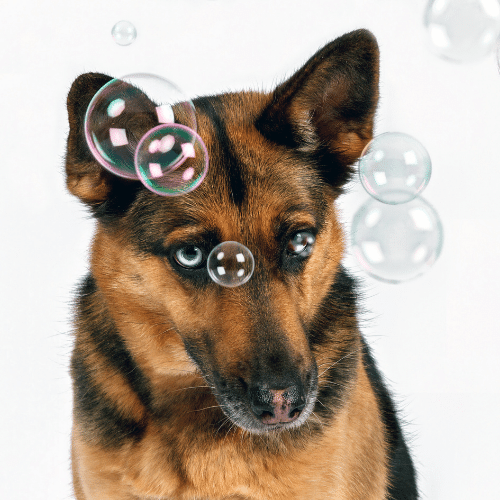Can a German Shepherd have Blue Eyes?
August 6, 2021 2021-08-09 8:28Can a German Shepherd have Blue Eyes?
Blue eyes are considered a fault in German Shepherds. They can occur thanks to a genetic variant in purebred dogs. However, they are not part of the breed’s standard and are not considered “normal.”
Dogs with blue eyes can’t be shown in competitions, for instance. This fact automatically makes them less valuable to breeders than dogs that can be shown in competitions.
Because they are considered a fault, blue eyes are becoming rarer and rarer. Breeders purposefully don’t breed German Shepherds with this trait. Instead, most of them are neutered and sold as pet dogs. A breeder may continue to use a blue-eyed dog for breeding in rare cases, but only if they have exceptional features otherwise.
The rarity is increased even more due to the recessive nature of this trait. Both parents have to be carriers of this gene for their puppies to have blue eyes. Brown eyes are dominant, which means that they will cover up the blue eyes trait.
A dog may technically have blue eyes – but still, end up with brown due to a dominant brown-eyed gene.
It is essential to realize that breeders aren’t always focused on producing a healthy dog. Instead, many of them focus on matching the breed standard – which means not using dogs with blue eyes in breeding programs.
Breeders that breed show dogs will not have blue-eyed dogs available. However, you may be able to find them produced by breeders that concentrate on pet dogs. These people may even purposefully breed them because they are sometimes sought after by those looking for a pet.
Table of Contents
What Color Eyes Can German Shepherds Have?
German Shepherds usually have brown eyes. This color is the most common and recognized by the breed standard. When many people breed German Shepherds, they aim to breed dogs with brown eyes.
The brown-eyed gene is dominant. This means that the dog only needs to inherit one gene for its eyes to be brown. On the other hand, most other eye genes are recessive; the dog must receive two to develop the other eye color.
The shade of brown can vary widely, though. Some dogs have dark brown eyes, while others are more of a tan. It largely depends on the amount of melanin a dog produces. More melanin equals a darker shade.
A single gene does not control a dog’s eye color. There are multiple traits involved. Therefore, it is hard to predict exactly what a dog’s eyes will look like.
Whether they are brown or blue is pretty easy to work out, but all the traits determining the shade can make determining their end eye color rather tricky. They may look like one of their parents – or they may not work at all.
Do German Shepherd’s Eyes Change Color?
Like most mammals, a German Shepherd’s eyes will develop over time.
When they are first born, a puppy will not produce all the melanin that they will when they get older (unless their eyes are a very light color – in which case they may never increase their melanin output). Therefore, most puppies will be born with light eyes, but they will darken as they get older.
Usually, their eyes will reach their final color by the time they are about ten weeks old. This can vary widely from dog to dog, though. Some dogs may have their final color much earlier. Others may develop them much later.
Some puppies may even be born with blue eyes – but these rarely stick around into adulthood. Typically, they will darken to brown within a few weeks.

What German Shepherds Have Blue Eyes?
There isn’t a particular type or color of German Shepherd that has blue eyes. These canines aren’t called something special that sets them apart from brown-eyed German Shepherds. Instead, they happen to have blue eyes instead of the usual brown.
This is a recessive trait, so your best chance of getting a puppy with blue eyes is to breed two blue-eyed adults.
If you breed a brown-eyed dog with a blue-eyed one, you may end up with 25% to 50% blue-eyed puppies. You may occasionally end up with a few blue-eyed puppies from breeding two brown-eyed dogs – assuming that they both have a recessive blue-eyed trait.
The most you will get from these pairings is 25% blue-eyed puppies, though. It won’t be substantial.
Some German Shepherd mixed breeds also have blue eyes. Usually, you’ll find blue eyes in German Shepherds mixed with other breeds that commonly have blue eyes. Siberian Huskies are a typical example of this.
Many Siberian Huskies have blue eyes. Therefore, if you breed them with a German Shepherd, your odds of getting a blue-eyed puppy are much higher.
Of course, brown-eyed dogs are much more common. This trait is still dominant – even when you’re mixing the German Shepherd with another breed. Finding two German Shepherds with blue-eyed traits is much more difficult than finding a Husky with blue eyes.
Do German Shepherds with Blue Eyes Have Extra Health Problems?
At the moment, it is unknown. There have been few studies done on blue-eyed German Shepherds simply because there are so few of them. It isn’t easy to do studies when these dogs are so rare.
Most German Shepherds with blue-eyes are also mixed breeds. Therefore, they can’t be used in studies, or they wouldn’t be accurate. You can’t account for the health problems caused by the blue eyes and those caused by the other dog’s genes.
There are some health problems associated with blue eyes in other breeds, though. This is primarily because of the decrease in melanin that these dogs produce. That’s what gives them blue eyes.
For instance, German Dalmatians with blue eyes are more likely to have sensorineural deafness. However, this study also found that there was obvious inheritability even when eye color was controlled for. Therefore, other genes involved caused the deafness – not just the blue eye color itself.
We don’t know if German Shepherds have a similar gene that interacts with the blue-eyed gene. It may be that the blue-eyed gene itself has a large enough effect to cause deafness – or German Shepherds may not be affected at all due to their lack of this other deafness gene.
Dalmatians also have an increased chance of being deaf if they have blue eyes. There have been other physical traits linked to increased deafness in Dalmatians in dogs, including the amount of spotting in their coat.
This may suggest that German Shepherds will have an equal chance of being deaf if they have blue eyes. However, this is not known for sure.

What About Merle German Shepherds?
There are no merle German Shepherds. They don’t carry the gene that makes them merle – it just isn’t possible.
However, mixed-breed German Shepherds may have the merle gene – depending on the dog they are bred with.
Sadly, the merle gene causes quite a few health problems. It isn’t uncommon for some breeders specializing in merle dogs to argue otherwise. However, the science is pretty clear on this topic.
Many proposed health problems may come along with a merle coat. However, only a few have scientific evidence supporting them.
Dogs with the merle gene are nearly twice as likely to be deaf or blind than those without it. Multiple studies have drawn these conclusions. These health problems likely stem from the decrease in pigment the dog creates, leading to problems with their eyes and ears.
Another common problem with merle dogs is that “double merles” almost always develop incorrectly in the womb. They typically don’t survive long enough to be born, and those that don’t survive for much longer after that.
Therefore, you can’t breed two merle dogs together because 25% of the puppies won’t make it.
Many breeders will not attempt to create merle German Shepherds for this reason. It isn’t a way to produce a healthier dog. And these canines would not be purebred. While this isn’t a problem for most pet owners, quite a few breeders will not purposefully mixed breeds together.
It makes the dog worthless since they cannot be shown.
Where Can I Find a Blue-Eyed German Shepherd?
Finding a blue-eyed German Shepherd is extremely difficult. For the most part, these dogs are rare. The blue coloration isn’t accepted by the AKC, which means they can’t compete in shows.
Most breeders produce dogs to be shown in the show ring. If the dogs can’t be shown, then it reduces their worth considerably. Other breeders won’t want the dog, as they haven’t been “proven” in the show ring.
However, some breeders don’t produce dogs for shows. Instead, they are focused on producing pet-quality dogs. In this case, they may purposefully breed dogs with blue eyes, as many potential pet owners are willing to pay a high price for these German Shepherds.
The “rare” tag can pay off for breeders who find enough blue-eyed German Shepherds to breed together.
If you’re looking for one of these dogs, your best bet is to find a breeder that specializes in rare colors (such as also the Black German Shepherd). These breeders are few and far between. You may have to travel quite far to find one. And the waiting list may be substantial.
If you want a dog now, you should probably settle on one with brown eyes.

Is There Something Wrong with Blue-Eyed German Shepherds?
Due to their rarity, some people assume that this is a defect. However, it is caused by a recessive gene – it just happens to be a rare one.
There may be some health problems associated with this gene. In other breeds, dogs with blue eyes are more likely to have certain health conditions. But we don’t know if this is the case with German Shepherds or not.
There haven’t been enough studies done on the blue-eyed version of these dogs because of their rarity. There aren’t enough German Shepherds around to run a study. Plus, the current need for studies is relatively low, as these dogs are often not very common.
While this gene is not a defect, that doesn’t mean that these dogs are free from different health problems.
If these dogs do have different health problems, the odds are likely not substantial. They might have a slightly higher chance of being deaf, for instance – but this chance will be meager.
There is no reason to avoid a German Shepherd with blue eyes due to the chance for health problems – it just doesn’t seem to increase the odds all that much. However, you may want to keep this in mind if you decide to adopt one.
If you notice that they don’t hear well, there is a higher chance that they aren’t due to their eye color.
Conclusion
Blue-eyed German Shepherds are very rare. The blue-eyed gene does exist in this breed. However, it is not nearly as common as the brown-eyed gene. Therefore, finding these dogs is difficult.
Many breeders do not produce German Shepherds with blue eyes because they cannot be shown. They will avoid breeding these dogs where possible, though some blue-eyed dogs may pop up occasionally. These are usually sold as pets since most breeders won’t want to continue the gene in their line.
If you’re looking for a blue-eyed GSD, you’ll probably need to go to a specialty breeder. These breeders usually market their dogs to pet owners. They, therefore, may produce blue-eyed dogs due to their appeal across the general population – even though they technically aren’t “proper,” according to the AKC.
We don’t have much health information about the blue-eyed GSD. There is a chance that these dogs will have an increased chance of deafness – but we just don’t know. Stay on the lookout for more studies, which may be published as this dog becomes more popular.

Author: Kristin
Kristin was born in Tennessee and currently lives there with her husband and children. She is passionate about educating pet parents and helping them make the best possible decisions for their pets. She currently owns one dog, two cats, a lizard, and a variety of fish.
Steffi Trott
Related Posts
Are Labradoodles High-Maintenance?
At what age do Labradoodles calm down?
Are Pomeranians Good for First-Time Dog Owners?
Are German Shepherds Hypoallergenic?
Are German Shepherds Smart?
Are German Shepherds Vocal?
Are German Shepherds Good With Kids?
Do Bernedoodles like Water?
Do Bernedoodles Like Cats?
How Long Can Australian Shepherds Be Left Alone?
Check out our effective and affordable online dog training courses!
-
Sale Product on sale
 Tackling Reactivity Bundle
Tackling Reactivity Bundle
MONEY BACK GUARANTEE$564.00$49.00 -
Sale Product on sale
 Perfect Obedience Bundle
Perfect Obedience Bundle
MONEY BACK GUARANTEE$349.00$49.00 -
Sale Product on sale
 Ultimate Puppy Bundle
Ultimate Puppy Bundle
MONEY BACK GUARANTEE$416.00$49.00 -
Sale Product on sale
 The Perfect Focus Bundle
The Perfect Focus Bundle
MONEY BACK GUARANTEE$445.00$169.00 -
Sale Product on sale
 Ultimate Masterclass Bundle
Ultimate Masterclass Bundle
MONEY BACK GUARANTEE$2,213.00$499.00











